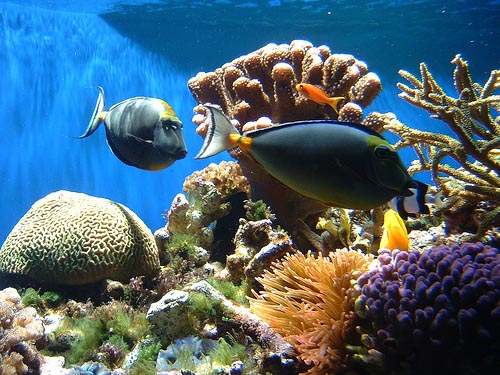 |
Home About Directory Conservation |
 |
Gulf of Mannar Reefs Location: 90 0’ 0 N and 790 48’ 0 E to 80 36’ 0 N and 800 0’ 0 E; 995068 N and 368094 E to 950773 N and 389963 E; in the North-western coast north of Talawila and south of Mannar Island, Puttalam and Mannar Districts of the North-western and Northern Provinces. Area: Exact reef area unknown. Altitude: Sea level to depths of over 30m Overview: The Gulf of Mannar has some of the most extensive reef formations and marine seagrass beds in the country. In addition to the coral reef systems of the Bar Reef, there exist several other reef formations to the south off Kandakuliya and Talawila, and northwards towards Mannar, including reefs off Silavaturai and Vankalai. The status of reefs within the northern Gulf of Mannar are not well known due to a lack of access, but many reefs in the southern Gulf of Mannar are now in a degraded condition due to overfishing and the use of destructive fishing methods. However, the area supports high species diversity due to its extent and variety of habitats. Physical features: Reefs in this area are very similar to those within the Bar Reef, and consist of shallow continental shelf patch reefs and deeper sandstone reefs. Most coral patches are located within depths of 1-10m, while sandstone habitats are located deeper, often down to 30 m or deeper. The reef in Talawila rises sharply from a sandy bottom on its shoreward side to an outer reef slope on the seaward side. There is a shallow reef built upon sandstone and dead coralline structures in Mampuri. Coral patches off Kandakuliya and Silavaturai resemble those of the Bar Reef. Ecological features: Shallow reefs off Silavaturai and Vankalai are dominated by branching and tabulate Acropora spp. Reefs off Kandakuliya are heavily degraded and are now overgrown by algae with little live coral. Talawila reef and Mampuri reef have relatively low coral cover but support high species diversity dominated by the genera Favia, Favites, Goniastrea, Leptoria, Platygyra, Pocillopora and Acropora. The reefs are important habitats for commercially important fish belonging to the families Lutjanidae, Lethrinidae, Heamulidae, Serranidae and Carangidae. Noteworthy fauna: Several globally threatened fish species such as Cheilinus undulates, Aetomylaeus nichofii, Epinephelus lanceolatus and Rhincodon typus have been recorded from the area while two species restricted to Sri Lanka (Chlorurus rhakoura and Plectorhinchus ceylonensis) are also found in the area. Carcharhinus melanopterus and Trionodon obesus are also common in shallow reef areas while one nationally protected species (Labroides bicolor) has been recorded from the area. The reefs are visited by all 5 species of globally endangered marine turtles found in Sri Lanka (Eretmochelys imbricata, Dermochelys coriacea, Chelonia mydas, Lepidochelys olivacea and Caretta caretta). Important marine mammals include small cetaceans such as Tursiops truncatus and Stenella longirostris, large whales such as Balaenoptera musculus and Physeter macrocephalus, and the dugong (Dugong dugon) Noteworthy flora: There is a high diversity of marine algae including Halimeda spp., Caulerpa spp., and Sargassum spp. Marine seagrasses include the genera Thalassia and Halodule. Land use: Fisheries, including collection of ornamental fish, chanks and sea cucumbers are the major activities carried out on the reefs. Possible changes in land use: Continued reef degradation may lead to decreased fish catches and changes in fishing methods and catch composition. This has already been witnessed in the Kandakuliya area where bottom set nets have degraded the reef resulting in reduced production of high value fish species. Increased competition for resources is also driving fishermen to use more destructive fishing methods such as the use of dynamite and purse seine nets, as well as target new resources and species. Hydrological and biophysical values: The Gulf of Mannar region comprises the most extensive and diverse system of coral reefs in Sri Lanka. Together with the abundance of other habitats such as sandstone reefs and seagrasses, this area constitutes a unique eco-region within the Indian Ocean. Reefs to the north off Silavaturai and Vankalai may be the source of coral recruits for reefs located further south including the Bar Reef, as recruitment is thought to occur during periods when currents move southwards during the northeast monsoon. The reefs also play an important role in regulating local current patterns and are important in stabilizing shorelines and assisting in the accretion of sediments and sand cays within the northern Gulf of Mannar. Social and cultural values: This area is of historic importance due to the location of some of the earliest ports and settlements in Sri Lanka. Reefs in the area are also important for supporting livelihoods and the food security of local communities. Scientific research and monitoring: Reefs in the southern Gulf of Mannar, such as Kandakuliya and Talawila, have been studied by NARA. Reefs in the northern Gulf of Mannar have not been studied due to the conflict situation in the area. Conservation education: Information not available Recreation and tourism: Information not available Conservation measures taken: Information not available Conservation measures proposed: The Gulf of Mannar area has been proposed as a SAM site by the CCD. Disturbance and threats: The use of destructive fishing methods such as dynamite and bottom set nets has caused extensive damage to reefs in the area, while overfishing is depleting populations of reef fish and pelagic species. Bycatch of marine turtles and cetaceans is also a problem, while poaching of turtles and turtle eggs is carried out, particularly around Mannar. Coral bleaching has also resulted in extensive mortality of corals in shallow areas while infestations of the invasive Acanthaster planci have degraded some reefs in the past. Land tenure: State owned Management authority and jurisdication: DFAR for managing fisheries, and the CCD for management of the coastal zone. References: Öhman et al. (1993); Öhman et al. (1997); Rajasuriya (2005); Rajasuriya et al. (1995); Rajasuriya et al. (1997) |
| Maps |